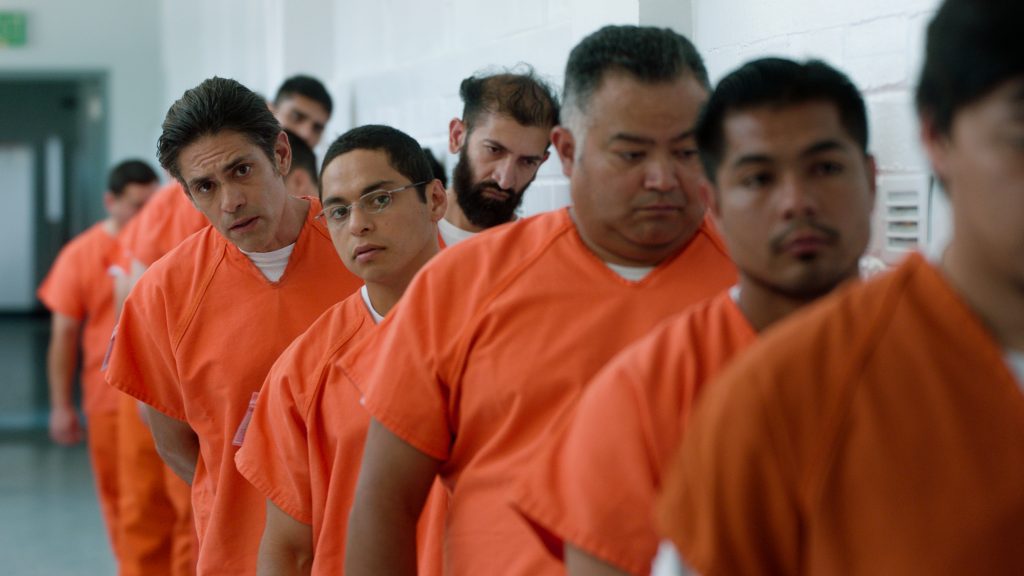November 12, 2021
by Carla Hay

“Mother, I Am Suffocating. This Is My Last Film About You.”
Directed by Lemohang Jeremiah Mosese
Culture Representation: Taking place in an unnamed African country, the docudrama film “Mother, I Am Suffocating. This Is My Last Film About You.” features an all-African group of representing the poor and working-class.
Culture Clash: An unnamed African woman, who currently lives in Berlin, gives a stream of consciousness narrative about her love/hate relationship with her biological mother and Mother Africa.
Culture Audience: “Mother, I Am Suffocating. This Is My Last Film About You.” will appeal primarily to people who are interested in watching movies that take an abstract approach to issues of colonization and immigration.

Contemporary movies about Africa are usually very predictable in their subject matter: They’re usually about poverty, war and/or refugees. “Mother, I Am Suffocating. This Is My Last Film About You., ” filmed entirely in black and white, takes the unorthodox approach of telling an abstract cinema story of an African expatriate who has a love/hate relationship with Africa. Written, directed band produced by Lemohang Jeremiah Mosese, the movie has been described as a documentary. However, it’s more like a docudrama, since there are actors who perform scenes among non-actors who are going about their everyday lives.
In addition, the unnamed woman giving the movie’s voiceover narration at times seems to be reading from a manifesto and other times seems to be rambling off the top of her head. (Sivan Ben Yishai is the actress who does the voiceover narration.) All the words in the movie are scripted, of course. They were written by Mosese, who makes a very unique feature-film debut with “Mother, I Am Suffocating. This Is My Last Film About You.”
No one is identified by name in this movie. However, these are the on-screen cast members who are listed in the movie’s end credits: Thato Khobotle, Mercy Koetle, Napo Kalebe, Molibeli Mokake, Pheku Lisema, Disko Monaheng, Chris Mosalemane and Teboho Mochao. And although the movie does not name the African country where the unseen narrator is originally from, the movie’s production notes lists Lesotho as the African nation where the movie was filmed. Some production also occurred in Qatar.
There’s only one consistent character seen on screen throughout the entire movie. She is a young woman (played by Khobotle), who is carrying a large wooden crucifix (just like Jeses Christ) in various locations. She’s also dressed in simple robe-like garb, much like how Jesus is depicted in artwork of Jesus carrying the cross on the way to being crucified. The woman in this movie doesn’t have a crown of thorns, but her physical exertion through sweat gets more emphasis as time goes on in the movie, until it reaches a point where there’s a close-up of her skin glistening with sweat.
As this cross-bearing woman walks through different places, such as a farm field and a crowded outdoor marketplace (the two main recurring locations in the movie), various “slice of life” scenarios play out on screen. In the field, a farmer holds his sheep. Later, a herd of sheep is brought to the marketplace, as potential buyers rub the sheep’s coats to feel the quality of the wool. And there’s another scene that shows the stark reality of sheep being used for meat, as an unidentified man is seen in slow-motion carrying a skinned, headless sheep through the marketplace.
Vendors in the marketplace shout out the prices of the merchandise: “10 rand clothes! 5 rand clothes!” People mill about in the marketplace and in a car-filled parking lot. Some of the people on the street gather to watch a man give a passionate speech on a platform, as he holds up a book that might or might be a religious book. Other people dance to music that’s not heard in the movie.
One person who stands out in the marketplace is an androgynous man, a non-binary person or a transgender woman (played by Kalebe), who is wearing a white tank top, denim shorts and angel wings. People give stares indicating that they’re shocked or curious, but this visually striking person gives a “not bothered” smile while striding confidently through the marketplace. Elsewhere, a mother unravels yarn that is completely wrapped around the head of her son who’s about 8 or 9 years old. Don’t expect any of the people shown in the movie to have their stories told.
The only story being told is that of the mysterious, unseen and unnamed narrator. Her voice is heard in an audio recording that has a slight echo, as if the recording could’ve been made yesterday or years ago. What she reads sometimes sounds like she spent a lot of time thinking about what she wanted to say, while other times she goes on a rant that seems more spontaneous. She talks about a letter she wrote to her mother: “By the time you read it, I will already have left you.”
Viewers will never know this narrator’s full story, but they will find out quickly that she has mixed feelings not only for her biological mother but also for Mother Africa, her homeland. As she recalls memories both good and bad of her mother, she goes through a range of emotions: joy, wistfulness, anger, sadness, confusion, hope. Sometimes she’s arrogant, sometimes she’s humble. Sometimes she’s strong, sometimes she’s vulnerable. And she keeps repeating to her mother that this is the last film and the last letter where she will talk about this mother.
Toward the end of the film, she reveals that she’s currently living a completely different life in Berlin, where she has made new friends (all white people, she says) who have accepted her, but still think that she’s “different.” She says with some condescension that the only reminders of Africa that she sees in her new life in Germany is when she stands in a Berlin airport line for people with non-European passports, or when she sees drug dealers who are black, or when she sees black people in menial service jobs.
Issues of race and colonization are brought up throughout the movie, because the narrator is very bitter about how much of African culture was stolen, erased or disrespected because of colonization. Early on in the movie, she hypothetically asks if her mother would wave a napkin to say goodbye to her, just like it’s done in European movies. “We are better in our goodbyes, I guess, than they are.”
Her most resentful remarks are when she describes how her mother underwent a religious conversion and changed into someone she didn’t know or like very much. “You used to listen to Michael Jackson,” she says. “You would whistle every tune, every song from ‘Thriller.’ You were the best.”
She adds in an infuriated manner: “Then religion came. Every novel, every book in the house, was replaced by holy men. The dresses became longer and longer. Your beautiful hair became too sacred for the world to see. You stopped looking into my eyes … The laughter, it all changed … You changed. You started to talk differently … You became cold and distant.”
She also describes her mother becoming fixated on the “end times.” Although the transformation of this mother could easily sound like the religious conversion of one person, as time goes on in the movie, it becomes more obvious that the narrator is upset about how Africa has changed because of religions forced on Africans by colonizers. The movie also has an audio clip (it’s unknown if it’s real or scripted) of a man with a European accent speaking to a boatful of refugees. “Who speaks English? How many people are in the boat?”
The narrator’s says to her mother in a voice filled with rage: “I’m ashamed of you! Your shame is yours to keep and mine to bear. I’d rather be in an immigrant in a foreign land than suffocating in your womb!.” Later, she says, “I saw you through the white man’s eyes. You deserve your war.”
She also repeats, “I love you” and “I hate you” several times when addressing her mother. And she also expresses remorse for an act of violence that she committed when she was 8 or 9 years old, when she used a knife on another child of about the same age. “I know I wasn’t a perfect child. All I needed was you, mother,” she says with sadness and regret.
Viewers who prefer formulaic narratives and plots in movies might have a hard time digesting “Mother, I’m Suffocating. This Is My Last Film About You,” even though the movie’s total running time is only 76 minutes. This is a movie that’s intended to take meaningful personal messages and blend them with imagery resembling a fever dream. The narration can at times be poetically articulate or frustratingly disjointed. But the movie’s most powerful statement is saved for the very end. It’s an impactful commentary on how personal history can shape someone’s identity, no matter how someone might want to forget, ignore or erase it.
Dekanalog released “Mother, I Am Suffocating. This Is My Last Film About You.” in select U.S. cinemas on November 12, 2021.




